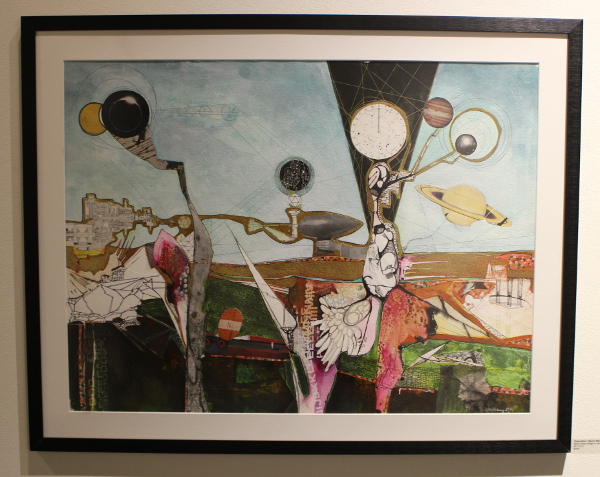
Scientific montages by Jen McCleary remind us where we are
For Jen McCleary, the creative process involves assembling a unified vision of surreal and scientifically based parts regardless of the medium. In the Hall at Crane Arts, the InLiquid artist lines up over a dozen of her collages – both digital and cut paper – in a content heavy, illustrative montage of outer space, biology, technology and urban decay.
In “Invention,” we see the profile a suited man in black and white as he looks between a pair of machines. One of the contraptions is round and contains gear-like parts, while the other is a monolithic column consisting of only the outlines of metal bars, plates, screws, rivets and the like. Since the lines of the larger, vertical apparatus are not filled in, the patterned background that the artist digitally laid into the piece shows right through the transparent form. From the tip of the man’s pencil, two lines emerge and connect to two circular areas on the larger structure. Due to its ethereal, dreamlike appearance, one can surmise that the man is merely imagining the invention and working to make it a reality. Each of the circular areas could be fitted with a version of the round machine near the man’s head, and this ode to the inventor seems to capture the subject at the moment of inspiration as he finishes work on the device.
Jen McCleary, “Grow.”
One of the more lush pieces here is aptly titled “Grow” and contains a colorful assembly of leaves, stems, buds and blossoms. As if the apparent depiction of plants weren’t enough, McCleary delves beyond the visible exteriors of these organisms to examine what is happening at a microscopic level by detailing what appear to be filaments, cellular structures and chloroplasts. Utilizing a mixed media approach on paper, her assembly process itself mimics a reverse dissection by carefully piecing parts together instead of gingerly taking them apart.
Jen McCleary, “Exploration: Space Age.”
We may also find McCleary venturing into the far off reaches of the solar system, and perhaps further still, in “Exploration: Space Age.” While the lower half is filled with lively greens and patterns that resemble aerial views of urban areas, as we get higher, planets and other celestial bodies seem to have come to our very doorstep. The sky itself remains mostly a baby blue hue, hinting that the oxygen of our atmosphere is present, and we are still at home on earth. Still, we find Jupiter, Saturn and some other nebulae or galaxies anchored to the ground with tendrils, hands, lines and other protrusions as they orbit in far closer proximity than reality. If Jupiter were this close, we might have to fear its gravitational disruptions, but instead it appears connected only metaphorically by way of our scientific inquiry. The curiosity that led us to explore even these locales that, by all accounts, are really in our own backyard, serves to remind us of the fact that we are merely beginning to venture away from the lush, watery rock on which we reside.
These and many more of Jen McCleary’s collages will be on display in the Crane Arts Hall through November 7.
Crane Arts is located at 1400 North American St., Philadelphia; [email protected]; cranearts.com.
Recent Content
-
Artsarticle ·
-
Artsarticle ·
-
Artsarticle ·


